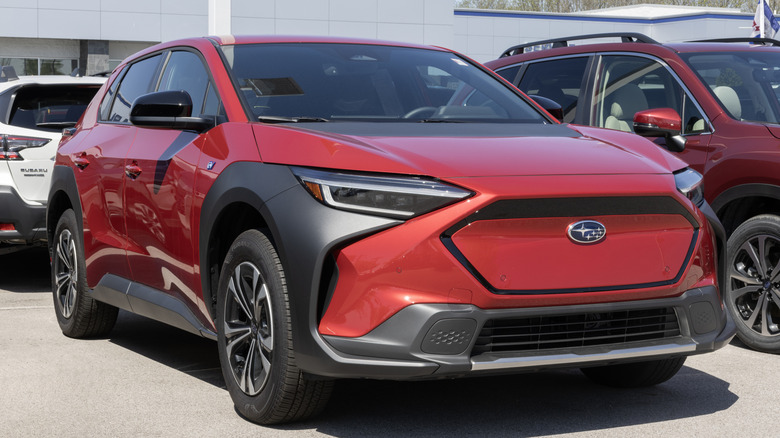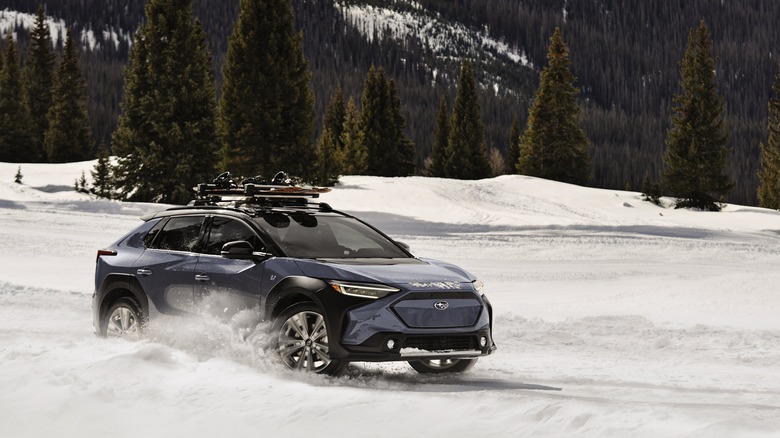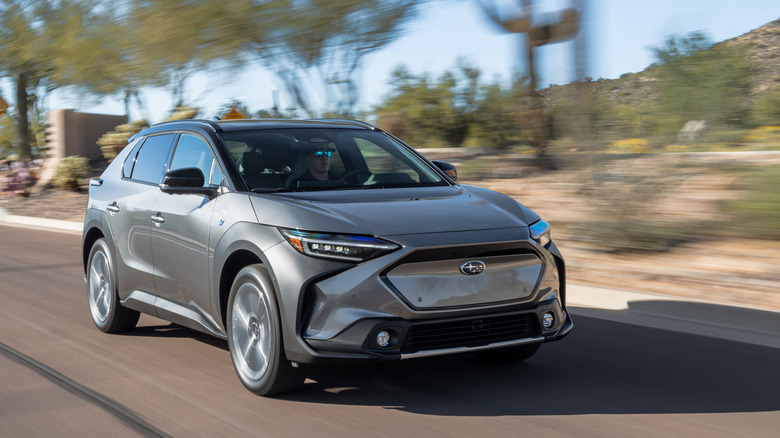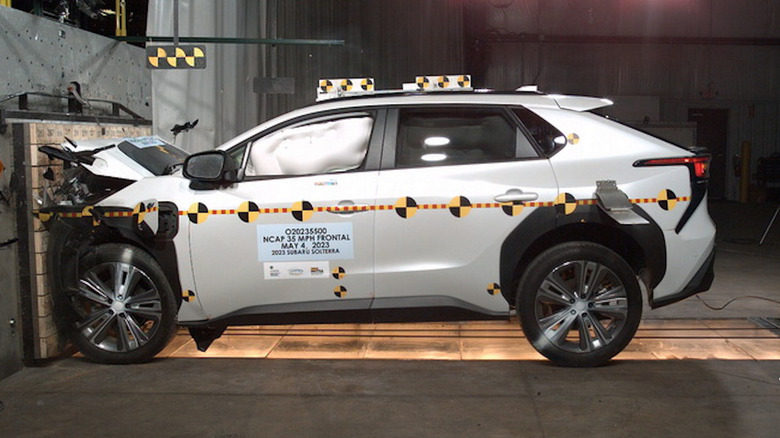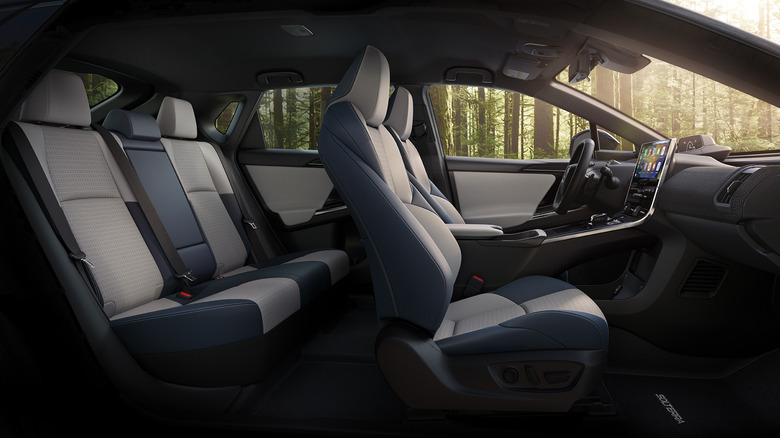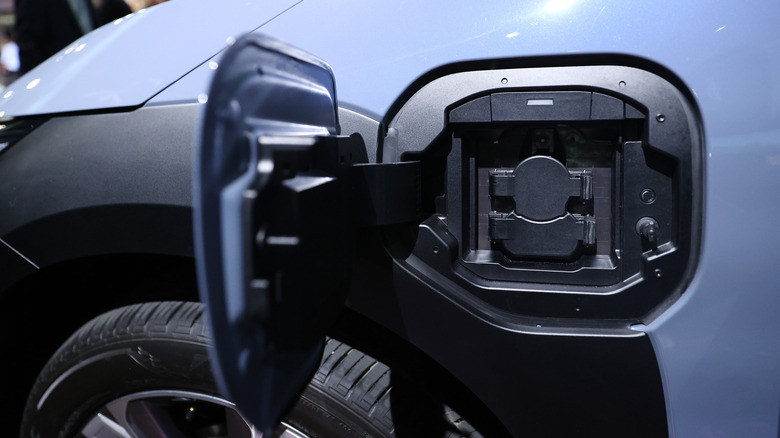Yes, Subaru Does Make A Fully Electric Car — Here Are Its Pros & Cons
We may receive a commission on purchases made from links.
With the launch of the Solterra, a mass-market Subaru electric car became a reality for the 2023 model year. Rather than create an EV from the ground up, Subaru turned to Toyota, its collaborator on other projects like the BRZ and GR86 sports coupe twins and business partner (Toyota owns 21% of Subaru), which was developing the bZ4X. The resulting vehicles are the Subaru Solterra and Toyota bZ4X, another pair of clones, with the differences marked mostly by packaging and badges.
Sales for this two-row crossover are modest at best. In 2024, the Japanese automaker sold about 12,500 units in the U.S., compared to almost 182,000 examples for its best-selling Crosstrek. This lackluster performance may be explained by more popular offerings like the Tesla Model Y, Ford Mustang Mach-E, and Hyundai Ioniq 5.
Nonetheless, Subaru has a loyal following, and there's market pressure for any car company to join the EV crowd. With this in mind, we'll examine where the Subaru Solterra holds its own and where it underwhelms.
Pro: It has standard all-wheel drive
Subaru made a name for itself by making all-wheel drive (AWD) standard on most of its vehicles. So, while Toyota offers the bZ4X with front-wheel drive, the Solterra is strictly AWD. Still, the 2025 Solterra comes with a lower starting price ($38,495) than the equivalent AWD bZ4X ($39,150).
The Solterra's AWD system was the focus of Subaru's contribution to the joint venture — a natural choice given Subaru's experience in getting all four corners to spin. The results show. In 2024, Car and Driver reported, "The Solterra boasts greater all-terrain abilities than most of its peers." This capability comes from an upgraded version of Subaru's X-Mode technology, which improves off-pavement handling. There are two settings: Snow/Dirt and Deep Snow/Mud, which are also found on select Ascent, Crosstrek, Forester, and Outback trims. Standard hill descent control also improves Solterra's prowess on steeper terrain, but this EV is no rock climber.
Pro: It's highly drivable
There's no getting around the Solterra's good but not great enough acceleration pace. At 6.1 seconds for a zero-to-60 mph dash, it's quicker than many other cars on the road. However, straight-line performance falls behind the Model Y, Mustang Mach-E, and Ioniq 5 trio, which can achieve the same results in under five seconds. So, while the Solterra's zero-to-60 capability isn't exactly a complete positive, it's not quite a negative either.
Nonetheless, the Solterra comes out ahead in some drivability factors. Notably, the Solterra's 8.3 inches of ground clearance exceeds the 5.7 to 6.8 inches offered by the others. This doesn't make the Solterra an off-road monster but is handy on unpaved roads and over tall speed bumps. A 36.7-foot turning diameter makes the Solterra nimble in urban settings and other tight squeezes. In contrast, the Model Y requires 39.8 feet to make a 360-degree turn.
Pro: It's got great safety features.
Safety sells family vehicles, something that Subaru has relied upon for years. While the Solterra has little in common with its gas-powered stablemates, it does carry on the company's tradition of protecting passengers.
The National Highway Traffic Safety Administration gives the car a top five-star overall safety rating. In specific testing, the Solterra achieved similar results, only dropping to four stars in the rollover evaluation (common with SUVs) and the front driver-side barrier assessment. In addition, the 2025 Solterra receives the highest ranking—Top Safety Pick+—from the Insurance Institute for Highway Safety (IIHS). It also receives top results in IIHS's unique crash testing, which focuses on more real-world scenarios.
Subaru also packs the Solterra with numerous advanced driver assistance system (ADAS) technologies. All trims have automatic emergency braking, blind-spot monitoring, lane-keeping support, adaptive cruise control, emergency steering assist, and the usual suite of driver aids expected in a modern vehicle.
Con: It's cramped on space
The inherent advantage of a crossover body style is a spacious cabin and ample cargo space. At the same time, a tall roofline can offer a feel of airiness. Yet, the Solterra doesn't fully take advantage of these elements. The sloping liftgate can give second-row occupants a less spacious vibe and the thick D pillar adds to this effect, along with creating blind spots for the driver.
Meanwhile, the Solterra suffers from some tighter interior spaces. Namely, it has 35.3 inches of rear legroom, which is only 0.5 inches more than in the back seat of a Toyota Corolla sedan. This space is lacking compared to the 40.5 inches in the Model Y and 39.4 inches in the Ioniq 5. The Mustang Mach-E delivers 38.1 inches to stretch out in the second row.
Versatility takes a hit by the Solterra's 23.8 cubic feet of cargo space behind the rear seats, which is topped by 26.3 cubic feet in the Ioniq 5. The Model Y and Mustang Mach-E each offer over 34 cubic feet of hauling ability, reinforcing just how small the Solterra is in the back.
Con: Its range falls short
Range anxiety is still an issue, especially among would-be EV buyers. Research firm Recurrent determined that three out of four first-time EV shoppers were concerned about running out of power. This critical factor may explain Solterra's sales challenges. Depending on the trim and model year, the Solterra offers a maximum range of 222 to 227 miles.
It's a capability that trails front-runner EV crossovers. The latest Model Y can travel 100 miles more, while the cheapest AWD 2025 Mustang Mach-E with the extended range battery has a 300-mile range. The Ioniq 5 in AWD form is EPA-rated for 290 miles.
Battery size may explain some disparity, as a 72.8 kWh pack powers the Solterra. This compares to a 75 kWh battery for the Model Y, while the Mach-E and Ioniq 5 have 88 and 84 kWh battery packs, respectively. These battery sizes correspond with the mileage ranges cited above.
